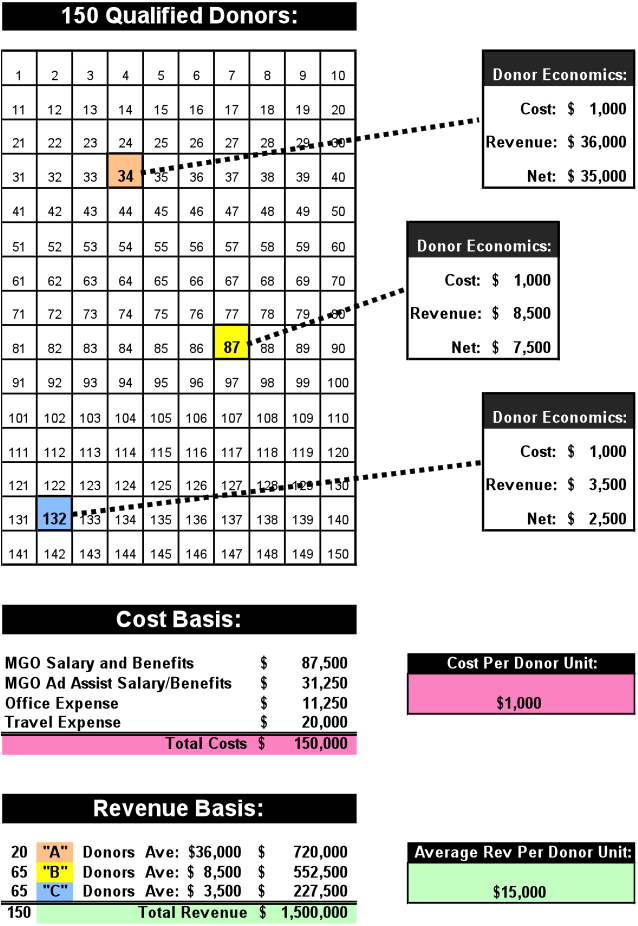#3 – Why It’s Important to Know the Cost and Revenue of each Donor on Your Caseload
“Return on investment (ROI) by donor?” Yup. “You mean like ROI in direct mail – there is such a thing in major gifts?” Yes. “Why does this matter to me?” Well, one reason is that someday, in your life as a major gift person, you will need to justify your existence to an authority figure outside yourself.
But there are other good reasons you should get into this material – the economics of your donors and of your caseload. Here are just a few:
- It helps you know that you can spend more cultivation time and money on certain donors.
- It helps you determine whether the time and money you spend on some donors is worth the return.
- It helps you figure out a more effective way to communicate with your donors.
- And personally, it gives you a clear understanding of how you are doing in your job.
So, how does it work? It’s quite simple. There are 150 qualified major donors on your caseload. (Qualified. You have personally determined they want to relate to you. Don’t just put anyone on there!). OK, 150 qualified donors.
They each have a certain revenue value. Why do you know this? Because you have created a goal for each donor on your qualified caseload – a goal that is based on past giving and future potential. (The sum of each donor’s goal is the value of your caseload).
Stay with me.
Now, go to the cost side. If you are part of a medium to large non-profit you, likely, as a MGO, have administrative support. My charts below make this assumption. If you are a one person shop, don’t worry. While the numbers will not apply to your situation, the concepts will.
So, on the cost side you have your salary and benefits, the salary and benefits of your support person, office expenses and travel expenses. You may have different categories but, in essence, it boils down to these four, in my opinion.
You’ll see in the chart below that I have made assumptions about what the costs are in each of those categories. So, the total cost of this Major Gift Unit is $150,000. (Again, if these numbers don’t work for you just stay with the concepts.) If the total cost is $150,000 and you have 150 donor units, the average cost per donor is $1,000.
Here is why it’s important to know this average cost number. It helps you realize how important it is to take care of each donor. If each one is costing $1,000 to steward (or whatever your number is) then you had better be stewarding each one! Otherwise the money is wasted. Thinking this way could be a useful motivational tool for you to manage your caseload properly.
Here is how this works together with the revenue for each donor. First, note, in the revenue basis box at the bottom, that I have tiered the caseload into A, B and C donors, all having different average revenue values. It is very important to do this with your caseload so you understand the relative value of each one. This will help you know how to spend your time.
Now, take a look at the chart below and note that it has 150 cubes representing 150 qualified donors. I have highlighted donors 34, 87 and 132 and put their value together with the average cost in the call out boxes to the right. The point of this exercise is to show that each donor has a different economy – a different revenue number and a different net number.
 Here is how this all ties together. This micro economy – this entire exercise – has several big practical points that apply to the real world you live in:
Here is how this all ties together. This micro economy – this entire exercise – has several big practical points that apply to the real world you live in:
-
- Each donor on your caseload is costing the organization something to manage. This is not a small sum of money. And knowing what it is should help motivate you to carefully steward each donor.
- Each donor on your caseload has a certain revenue value. Knowing what that number is will help you know how much time and effort to spend on that donor.
- If you manage both the cost and revenue of each donor the total sum of the effort will increase your caseload performance. Why? Because you will be working smarter and more effectively.
- All of this information will help you several ways:
-
-
-
- You will know when to delete donors from your caseload.
- You will be able to justify cost and time decisions against certain donors. You know what I mean. It’s when your manager asks: “How come you spent that on DONOR NAME?”
- You will have a clear understanding of the value of your work. This is good for the organization. But, more importantly, it is good for YOU. You can know, with certainty, that your labor is not in vain.
-
-
Counting the cost in major gifts seems like a very technical exercise. And it can be. But, hopefully, you have seen here why it is so important to know the ROI of your caseload and your donors.
Richard







At my first fundraising job, I worked for a Development Director who acted COMPLETELY as you’ve described above. She met an extremely rich couple with some interest in our cause (the wife was a dog therapy volunteer at our senior services organization). And from then on, it was all about them because she seemed to think that, as you said, we were just months away from a million dollar gift. She ignored other prospects and actual donors, even kicking someone out of her office once when this wealthy woman happened to stop by without an appointment. To make matters even worse, she ignored all other fundraising activities (annual giving, stewardship, events, marketing, etc.) except for the major gifts program (i.e., this one rich couple).
Although I was brand new to fundraising and knew very little about major gifts, my instincts told me this was wrong. This blog post certainly helps articulate why it was wrong! At the time I left that position, this rich couple still had not given any monetary gifts (even though the Director had the husband sign one of our appeal letters!) and it looked like the husband was going to join the Board of Directors at a “competing” organization. I don’t think the couple was really interested in making a more personal connection to us — they certainly weren’t qualified donors. The whole mess was really just a shame for that organization, because it actually did great work for seniors.
Perfect example, Heather. Perfect.
Isn’t it amazing how easy it is for a person to become so self absorbed that they REALLY think that “two donors in the bush are more valuable than one donor in hand”, to coin that bird in the hand saying? Sometimes I think that people like this just want to BE around the rich, famous and powerful vs. actually do their jobs! Even more interesting to me is the mental gyration the person has to go through to actually believe that what they are doing is right. A lot of drama…